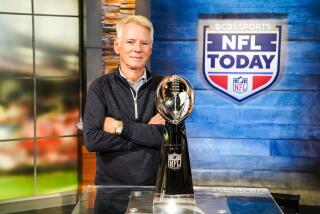Breakfast of Champions, Inspiration for Millions
- Share via
The magazine interviewer poised with his tape recorder. “When you were growing up as a kid, did you have any special sports heroes?” he wanted to know.
“You mean besides Jack Armstrong?” I asked.
“Who?” he said.
Now, that, I must say, is depressing. For anyone not to know who Jack Armstrong was is enough to make you want to join a monastery.
I mean, Jack Armstrong! The All American Boy. Loyal, true, trustworthy, kind. He could run faster, jump higher, throw harder and hit farther than anyone his age in the country. The pride of Hudson High, boys, the Shalokeebee champions known throughout the land. He was a hero on the order of the Merriwell brothers, a part of Americana like Paul Bunyan, Wyatt Earp. The embodiment of all virtues, he could do it all.
Next, somebody will be wanting to know who Willie Mays was. It’s shocking.
Jack Armstrong was important for another reason. He was the first Wheaties eater in our culture.
Now, surely, we’ve all heard of Wheaties. The Breakfast of Champions. The grain cereal that became part of the language. Why, Babe Ruth ate Wheaties. Or said he did. So did Lou Gehrig, Jimmie Foxx. Jack Dempsey himself.
The cereal became as famous as Popeye’s spinach as a symbol for strength. For years, if an athlete had a bad day the public joke was, “Well, he must not have had his Wheaties today.” They joked about them. But they ate them. Kids from one end of the country to the other dipped into their morning cereal, the boxes propped in front of them and pictures of their favorite athletes posted alongside.
Wheaties’ identification with athletics was total. The flakes had been discovered by accident in a kitchen in Minnesota in the early 1920’s. A technician dropped a puddle of liquefied wheat on a hot stove, a flake was toasted and a product was born. A contest was held to find a name, and Wheaties became, so to speak, a household word.
There was no evidence that, as part of the daily diet, Wheaties contributed one way or the other to athletic prowess, but the kids of America were taking no chances, because Wheaties very soon consolidated its identification with athletic excellence.
First, it broadcast the home games of the minor-league Minneapolis Millers and conceived the idea of giving away a case of Wheaties for every home run hit. Kids in the street soon began to refer to a long ball hit out of sight as “a case of Wheaties!”
As a fringe benefit in the tie-up with the triple-A team, the club threw in a center-field billboard. An inspired ad manager splashed the legend “Breakfast Of Champions!” across it and a legend was born.
Wheaties expanded into the big leagues. Announcers dispensed cases of Wheaties from Fenway Park in Boston to the South Side of Chicago and it was proof-positive that organized sports were among the most powerful selling tools in Madison Avenue’s chest.
“Breakfast Of Champions” became satirized, of course, to mean a six-pack and a cigarette, but even that helped. The product became so ingrained in the national consciousness that Lou Gehrig, who had been hired away to plug Huskies, a rival product, once spent an entire program saying Wheaties, causing slow death among the sponsors in the booth at the live broadcast.
Into this felicitous arrangement came Jack Armstrong, the All-American boy, the fair-haired hero of the airwaves. Everybody ate Wheaties for fear of offending him, or of not being able to send in a box top for his favorite exercises.
Wheaties stayed on its winning streak till well into the postwar era, when it allowed Jack Armstrong to hang them up.
Then out of the woodwork came those ever-present gadflies of our civilization, the all-purpose consumer advocates. They jeered at Wheaties for not having more vitamins or for not having more riboflavin or something. Not that the public paid any more attention than ever to consumer advocates, but General Mills’ lab technicians did and the resultant tinkering only insured that much of the market was then given over to pre-sugared cereals, if anyone could consider that an improvement.
Once Jack Armstrong was gone, the Wheaties image had to be resuscitated by the boundlessly energetic pole vaulting parson, Bob Richards. Perpetually smiling, non-stop talking, the Rev. Bob came to symbolize in real life the bursting good health Jack Armstrong had in make-believe.
Wheaties today is represented by America’s new sweetheart, Mary Lou Retton, Sam Snead and Bob Richards, all of whom were through here the other day to greet the new generation of cereal box sportsmen such as Peter Gagarin, whose sport is something called orienteering--figuring out where you’re going--Doug Heir, a wheelchair track and field champion; Jon Lugbill, a whitewater canoeist, and Jane Buch, a marathoner.
Champions all, I am sure, but they’re not Jack Armstrong now, are they?
And you can’t send away to get your magic decoding ring from them, can you?
More to Read
Go beyond the scoreboard
Get the latest on L.A.'s teams in the daily Sports Report newsletter.
You may occasionally receive promotional content from the Los Angeles Times.










